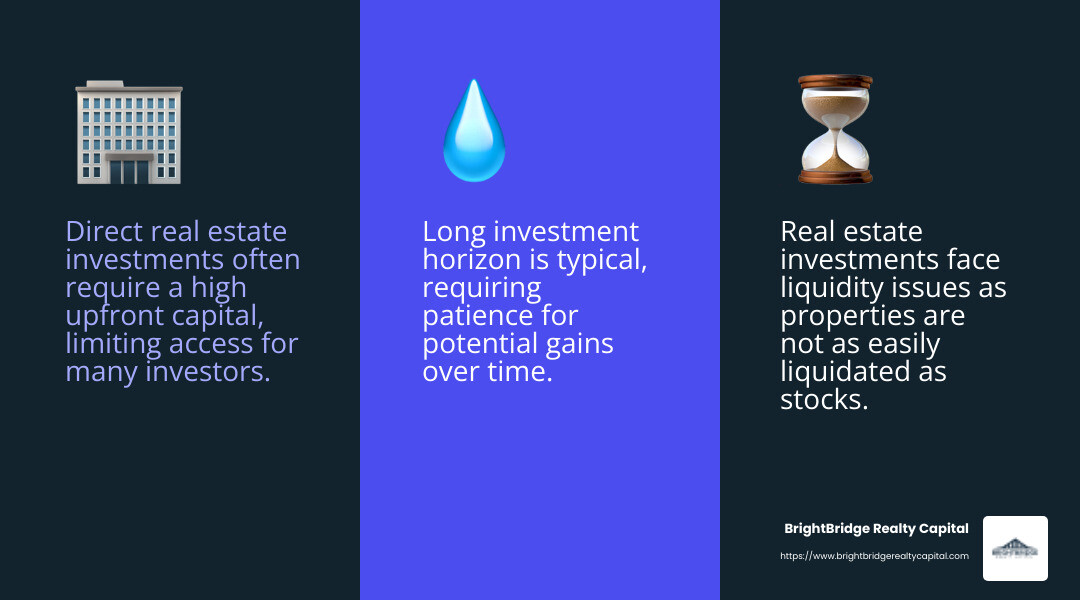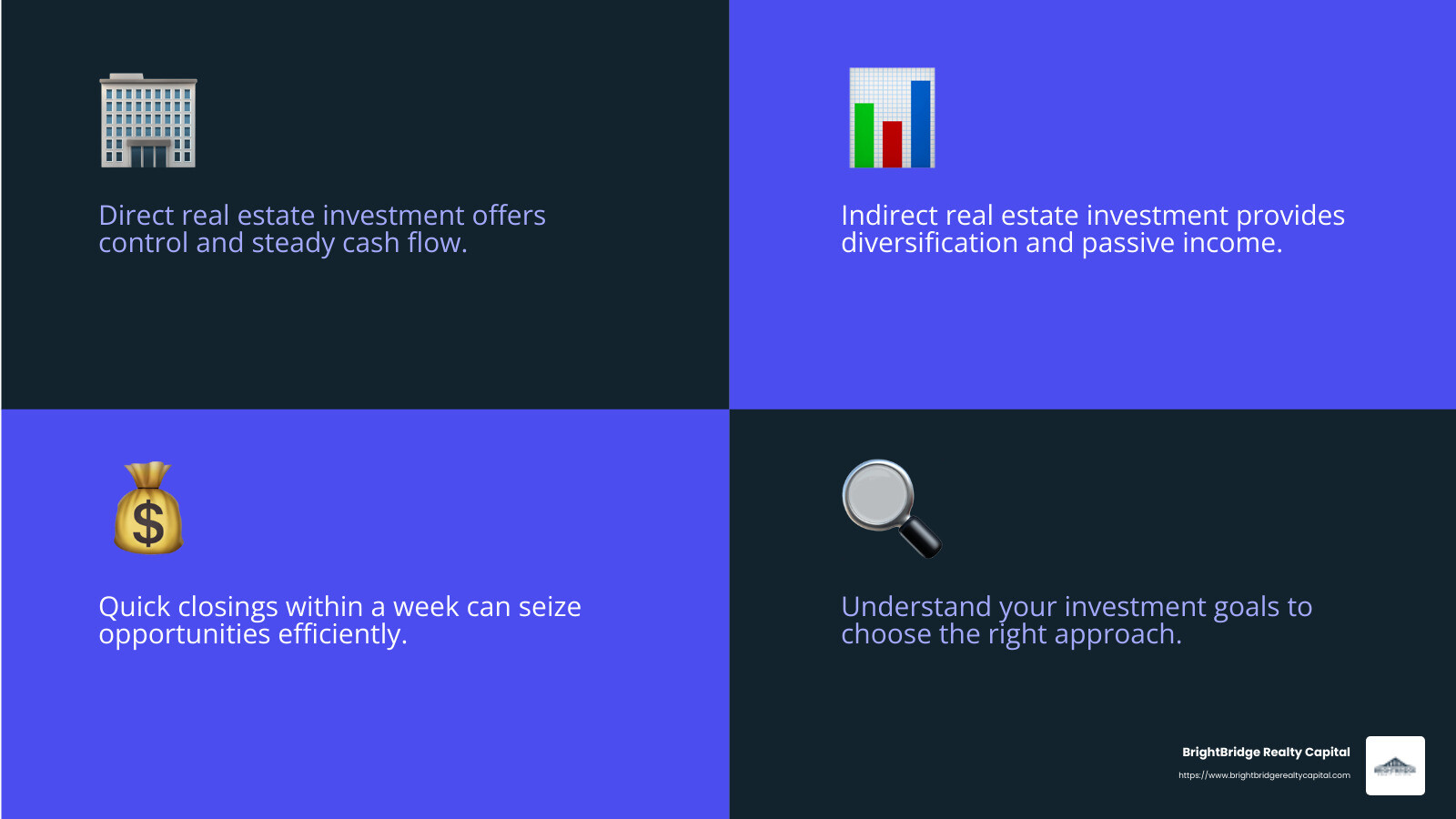Direct vs. Indirect Real Estate Investment: Which is Right for You?

Direct real estate investment is a cornerstone of wealth-building strategies for many investors. Here's why it might be right for you:
- Diversification: Real estate offers low or negative correlation to the stock market, reducing portfolio risk.
- Inflation hedge: Property values and rents typically rise with inflation, protecting your purchasing power.
- Investment stability: Real estate provides stable cash flows and tends to experience lower volatility than stocks.
Investing directly in real estate is more than just buying property; it’s about creating a secure, diverse portfolio. As markets fluctuate, the unique ability of real estate to stabilize returns becomes apparent. Unlike stocks and bonds, direct real estate investment provides a tangible asset that acts as a powerful guard against inflation. By passing increased operational costs onto tenants, property owners can maintain income levels, giving real estate its reputation as an intrinsic inflation hedge.
When you own property directly, you can benefit from consistent income and potential appreciation, offering both steadiness and growth—two highly desirable qualities in an investment. Plus, strategic sector selection, such as focusing on industrial properties or apartment complexes, can further improve returns in the current market.
Explore the distinct advantages of direct real estate investment and see how it can fortify your financial future.

Direct real estate investment definitions:
- types of loans for real estate investors
- real estate loans for investors
- private real estate financing
Understanding Direct Real Estate Investment
Direct real estate investment means owning a piece of property outright or holding an equity stake in it. This approach offers several distinct advantages and challenges that investors should consider.
Benefits of Direct Real Estate Investment
1. Control Over Investments
Direct ownership gives you the power to choose exactly where and how to invest your money. Want a property in a busy New York neighborhood? You can make that happen. Prefer a quiet suburban rental? That’s your choice too. This level of control allows you to tailor your portfolio to meet your personal and financial goals.
2. Tax Relief Opportunities
Owning property brings potential tax benefits. You can write off expenses like maintenance and management costs, which can lower your taxable income. Additionally, you might defer capital gains taxes through strategies such as the 1031 exchange. This means more money stays in your pocket.
3. Capital Appreciation Potential
Investing in real estate can lead to significant capital appreciation over time. As property values rise, so does your investment. This is especially true in up-and-coming areas where property improvements or market demand can boost value significantly.
Challenges of Direct Real Estate Investment
1. High Upfront Capital Requirement
Direct real estate investments often require significant initial outlay. The typical entry point is around $50,000, which can be a barrier for many investors. This high cost limits access, making it essential to have substantial capital available.
2. Liquidity Issues
Real estate is not as easily liquidated as stocks or bonds. Selling property can be a lengthy process involving brokers, lawyers, and other intermediaries. This lack of liquidity means your money is tied up, potentially for years, limiting your ability to respond to financial needs or market changes swiftly.
3. Long Investment Horizon
Real estate investments typically have a long-term horizon. It can take years to see a return on your initial investment, especially when accounting for market fluctuations and property improvements. This long timeline requires patience and a willingness to wait for potential gains.

Direct real estate investment can be a powerful tool in your financial arsenal, providing control, tax benefits, and growth potential. However, it also demands significant capital, patience, and a willingness to steer liquidity challenges. Understanding these factors is crucial as you consider whether direct ownership aligns with your investment goals.
Next, we'll explore indirect real estate investment options and how they compare to direct investing.
Exploring Indirect Real Estate Investment
If you're looking for a more hands-off approach to real estate, indirect real estate investment might be your answer. This method involves investing in pooled assets, typically through Real Estate Investment Trusts (REITs) or Exchange-Traded Funds (ETFs). Here's a closer look at the benefits and challenges of this investment strategy.
Benefits of Indirect Real Estate Investment
1. Passive Investing
One of the biggest perks of indirect investing is that it's largely passive. Unlike direct real estate investment, you don’t need to worry about property management or tenant issues. You invest your money, and the fund managers handle the rest. This "set it and forget it" approach is ideal for busy professionals or those who prefer minimal involvement.
2. Lower Capital Requirement
Entering the real estate market doesn't have to break the bank. With indirect investments, you can start with much less capital. For example, you can begin investing in REITs with a relatively small amount. This lower barrier to entry opens up real estate opportunities to a broader range of investors.
3. Diversification
Indirect investments offer excellent diversification. By investing in REITs or ETFs, you gain exposure to a wide array of properties without owning them directly. This spread of investment across multiple properties can help mitigate risk, providing a buffer against market volatility.
Challenges of Indirect Real Estate Investment
1. Taxation
Indirect real estate investments come with hefty tax implications. You must pay income tax on dividends and capital gains tax. This can eat into your returns, especially for those in higher tax brackets.
2. Lack of Control
When you invest indirectly, you give up control over where and how your money is invested. You can't choose specific properties or influence management decisions. This lack of control means you’re relying on the fund managers to make choices that align with your investment goals.
3. Transparency Issues
Indirect investments can sometimes feel like a black box. Information about individual properties, tenant details, and asset performance is often limited. This lack of transparency makes it harder to assess the exact nature of your investment.
Indirect real estate investment offers a convenient and accessible way to enter the real estate market. It provides the benefits of diversification and lower entry costs but comes with challenges like taxation and limited control. Understanding these factors is key to deciding if indirect investing aligns with your financial strategy.
Next, we’ll compare direct and indirect real estate investments to help you determine which option best suits your needs.
Comparing Direct and Indirect Real Estate Investment
Direct Real Estate Investment vs. Indirect Real Estate Investment
When deciding between direct real estate investment and indirect options like REITs, understanding the differences in risk-return profile, investment control, and liquidity is crucial.
1. Risk-Return Profile
Direct real estate investments often offer the potential for higher returns but come with increased risk. You have direct exposure to property appreciation and rental income. However, this also means you're more susceptible to market downturns in specific areas or property types.
In contrast, indirect investments like REITs spread risk across a portfolio of properties. This diversification can provide a more stable return, though often at a lower rate compared to successful direct investments.
2. Investment Control
With direct investments, you have significant control over your properties. You can decide on renovations, choose tenants, and set rental prices. This hands-on approach can be rewarding but requires time and expertise.
Indirect investments, on the other hand, relinquish control to fund managers. You don't select properties or manage them, which can be a relief for some but frustrating for those wanting a say in their investments.
3. Liquidity
Liquidity is a significant factor when comparing these investment types. Direct real estate is typically illiquid. Selling a property can take months and involves high transaction costs. This can be a disadvantage if you need quick cash.
Indirect investments like REITs offer much greater liquidity. You can buy or sell shares on stock exchanges with ease, providing flexibility to respond to market changes or personal financial needs.
4. Ownership Stake
Direct investors own a tangible asset. This ownership can provide a sense of stability and potential tax benefits, such as depreciation and mortgage interest deductions. However, it also means you're responsible for property management and upkeep.
In indirect investments, you own shares in a pool of real estate assets. This fractional ownership removes the burdens of management but also means you don't have a direct stake in any specific property.
5. Investment Strategy
Direct investment strategies often focus on long-term growth and income generation through property appreciation and rental income. Investors may target specific property types or locations based on personal expertise or market trends.
Indirect strategies, however, rely on fund managers' expertise to diversify across various real estate sectors and geographic regions. This approach is more about steady income and long-term capital appreciation without the need for active management.
6. Market Exposure
Direct real estate investments tie you to specific markets, which can be beneficial if you have local knowledge and insights. However, this concentration also exposes you to local economic fluctuations.
Indirect investments provide broader market exposure. By investing in REITs, you can gain access to various real estate sectors and locations worldwide, reducing the impact of any single market's downturn.
Understanding these differences can help you choose the right path for your real estate investment journey. Whether you prefer the hands-on approach of direct investment or the convenience of indirect options, aligning your strategy with your financial goals and risk tolerance is key.
Next, we'll answer some frequently asked questions to further clarify the nuances of real estate investment.
Frequently Asked Questions about Real Estate Investment
What are the disadvantages of direct and indirect real estate investments?
Direct Real Estate Investment Disadvantages
Risk Exposure: Direct real estate investment exposes you to risks tied to specific properties. If a property value drops or rental income decreases, your investment suffers directly.
Control Limitations: While you have control over the property, you also bear all the management burdens. This requires time, effort, and expertise.
Liquidity Issues: Selling a property is time-consuming and costly, making it hard to quickly convert your investment into cash if needed.
Indirect Real Estate Investment Disadvantages
Control Limitations: You lack control over individual properties since fund managers make all decisions. This can be frustrating for hands-on investors.
Taxation: Indirect investments like REITs often come with tax implications that differ from direct ownership, potentially reducing your after-tax returns.
Transparency Issues: The inner workings of funds or REITs may not always be clear, making it difficult to understand exactly how your money is being used.
What are the advantages of indirect real estate investments?
Diversification: Indirect investments spread risk by pooling money into a variety of properties. This reduces dependence on any single asset's performance.
Passive Income: You can earn income without the hassle of property management. REITs, for example, often pay dividends, providing regular cash flow.
Lower Capital Requirement: Indirect investments typically require less upfront capital, making them accessible to more investors.
How does liquidity differ between direct and indirect real estate investments?
Asset Holding Period: Direct investments often have a long holding period due to the time required to sell properties. This ties up your capital for extended periods.
Market Accessibility: Indirect investments like REITs offer high liquidity. Shares can be bought and sold on stock exchanges, allowing you to quickly react to market changes or personal financial needs.
Understanding these aspects can help you make informed decisions about whether direct or indirect real estate investment is right for you. Next, we'll dig into more specific questions to further clarify your options.
Conclusion
When it comes to real estate investment, understanding your investment goals is crucial. Whether you're looking for control, steady cash flow, or capital appreciation, knowing what you want helps you choose between direct and indirect investments.
BrightBridge Realty Capital stands out in the real estate financing world. We provide customized solutions that cater to your unique investment needs. Whether you're interested in direct real estate investment or prefer a more passive approach, our services are designed to support your goals.

Our ability to offer quick closings—often within a week—means you can seize opportunities without delay. We cut out intermediaries, providing competitive rates and a seamless process, ensuring your investment journey is smooth and efficient.
Explore our services and see how we can help you achieve your real estate investment goals. Visit BrightBridge Realty Capital to learn more and start building your investment portfolio today.


